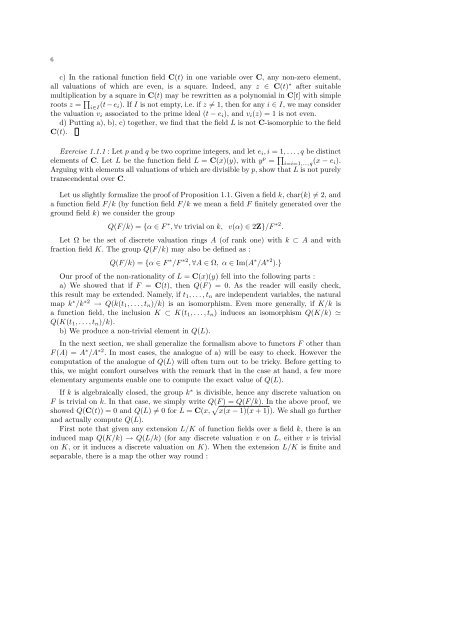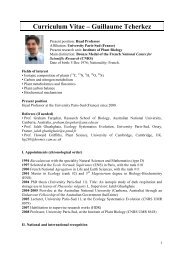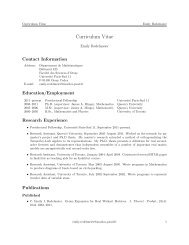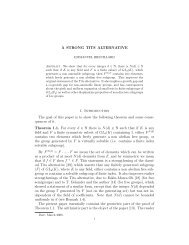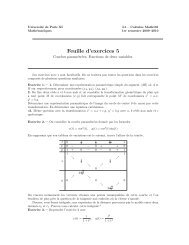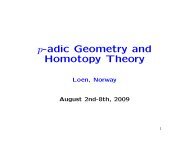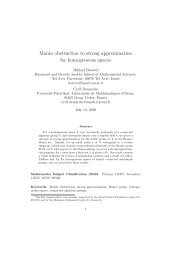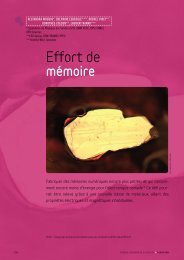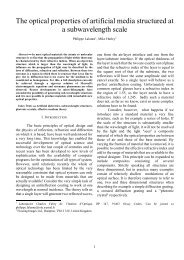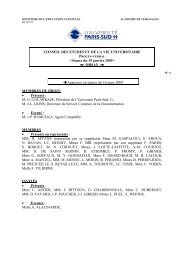Birational invariants, purity and the Gersten conjecture Lectures at ...
Birational invariants, purity and the Gersten conjecture Lectures at ...
Birational invariants, purity and the Gersten conjecture Lectures at ...
You also want an ePaper? Increase the reach of your titles
YUMPU automatically turns print PDFs into web optimized ePapers that Google loves.
6<br />
c) In <strong>the</strong> r<strong>at</strong>ional function field C(t) in one variable over C, any non-zero element,<br />
all valu<strong>at</strong>ions of which are even, is a square. Indeed, any z ∈ C(t) ∗ after suitable<br />
multiplic<strong>at</strong>ion by a square in C(t) may be rewritten as a polynomial in C[t] with simple<br />
roots z = ∏ i∈I (t − e i). If I is not empty, i.e. if z ≠ 1, <strong>the</strong>n for any i ∈ I, we may consider<br />
<strong>the</strong> valu<strong>at</strong>ion v i associ<strong>at</strong>ed to <strong>the</strong> prime ideal (t − e i ), <strong>and</strong> v i (z) = 1 is not even.<br />
d) Putting a), b), c) toge<strong>the</strong>r, we find th<strong>at</strong> <strong>the</strong> field L is not C-isomorphic to <strong>the</strong> field<br />
C(t).<br />
Exercise 1.1.1 : Let p <strong>and</strong> q be two coprime integers, <strong>and</strong> let e i , i = 1, . . . , q be distinct<br />
elements of C. Let L be <strong>the</strong> function field L = C(x)(y), with y p = ∏ i=i=1,...,q (x − e i).<br />
Arguing with elements all valu<strong>at</strong>ions of which are divisible by p, show th<strong>at</strong> L is not purely<br />
transcendental over C.<br />
Let us slightly formalize <strong>the</strong> proof of Proposition 1.1. Given a field k, char(k) ≠ 2, <strong>and</strong><br />
a function field F/k (by function field F/k we mean a field F finitely gener<strong>at</strong>ed over <strong>the</strong><br />
ground field k) we consider <strong>the</strong> group<br />
Q(F/k) = {α ∈ F ∗ , ∀v trivial on k, v(α) ∈ 2Z}/F ∗2 .<br />
Let Ω be <strong>the</strong> set of discrete valu<strong>at</strong>ion rings A (of rank one) with k ⊂ A <strong>and</strong> with<br />
fraction field K. The group Q(F/k) may also be defined as :<br />
Q(F/k) = {α ∈ F ∗ /F ∗2 , ∀A ∈ Ω, α ∈ Im(A ∗ /A ∗2 ).}<br />
Our proof of <strong>the</strong> non-r<strong>at</strong>ionality of L = C(x)(y) fell into <strong>the</strong> following parts :<br />
a) We showed th<strong>at</strong> if F = C(t), <strong>the</strong>n Q(F ) = 0. As <strong>the</strong> reader will easily check,<br />
this result may be extended. Namely, if t 1 , . . . , t n are independent variables, <strong>the</strong> n<strong>at</strong>ural<br />
map k ∗ /k ∗2 → Q(k(t 1 , . . . , t n )/k) is an isomorphism. Even more generally, if K/k is<br />
a function field, <strong>the</strong> inclusion K ⊂ K(t 1 , . . . , t n ) induces an isomorphism Q(K/k) ≃<br />
Q(K(t 1 , . . . , t n )/k).<br />
b) We produce a non-trivial element in Q(L).<br />
In <strong>the</strong> next section, we shall generalize <strong>the</strong> formalism above to functors F o<strong>the</strong>r than<br />
F (A) = A ∗ /A ∗2 . In most cases, <strong>the</strong> analogue of a) will be easy to check. However <strong>the</strong><br />
comput<strong>at</strong>ion of <strong>the</strong> analogue of Q(L) will often turn out to be tricky. Before getting to<br />
this, we might comfort ourselves with <strong>the</strong> remark th<strong>at</strong> in <strong>the</strong> case <strong>at</strong> h<strong>and</strong>, a few more<br />
elementary arguments enable one to compute <strong>the</strong> exact value of Q(L).<br />
If k is algebraically closed, <strong>the</strong> group k ∗ is divisible, hence any discrete valu<strong>at</strong>ion on<br />
F is trivial on k. In th<strong>at</strong> case, we simply write Q(F ) = Q(F/k). In <strong>the</strong> above proof, we<br />
showed Q(C(t)) = 0 <strong>and</strong> Q(L) ≠ 0 for L = C(x, √ x(x − 1)(x + 1)). We shall go fur<strong>the</strong>r<br />
<strong>and</strong> actually compute Q(L).<br />
First note th<strong>at</strong> given any extension L/K of function fields over a field k, <strong>the</strong>re is an<br />
induced map Q(K/k) → Q(L/k) (for any discrete valu<strong>at</strong>ion v on L, ei<strong>the</strong>r v is trivial<br />
on K, or it induces a discrete valu<strong>at</strong>ion on K). When <strong>the</strong> extension L/K is finite <strong>and</strong><br />
separable, <strong>the</strong>re is a map <strong>the</strong> o<strong>the</strong>r way round :


